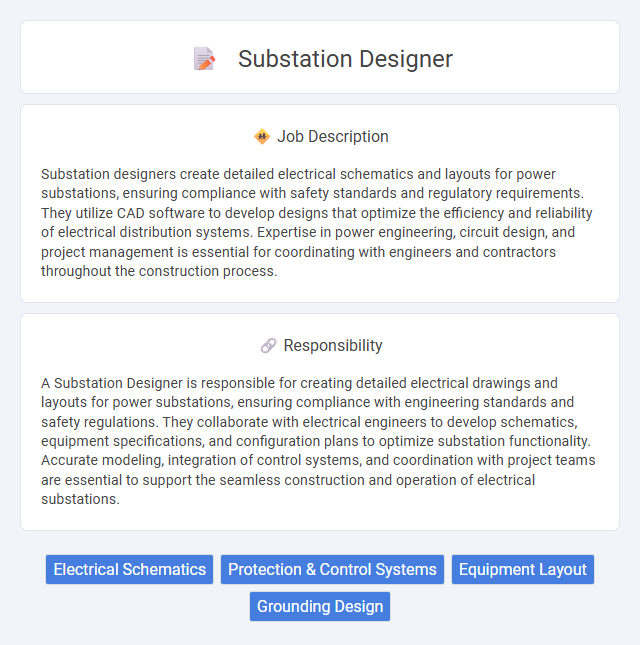
Substation designers create detailed electrical schematics and layouts for power substations, ensuring compliance with safety standards and regulatory requirements. They utilize CAD software to develop designs that optimize the efficiency and reliability of electrical distribution systems. Expertise in power engineering, circuit design, and project management is essential for coordinating with engineers and contractors throughout the construction process.
Individuals with strong analytical skills and an aptitude for technical drawing are likely to be well-suited for a substation designer job. Those who prefer structured environments and possess attention to detail may find this role aligns with their work style. People uncomfortable with complex electrical systems or high-responsibility tasks might face challenges adapting to this profession.
Qualification
A Substation Designer must possess a degree in electrical engineering or a related field, with strong expertise in power systems and substation layout design. Proficiency in industry-standard software such as AutoCAD, MicroStation, and ETAP is essential for creating detailed and accurate schematics. Experience with electrical codes, standards like IEEE and IEC, and knowledge of protective relaying and grounding systems are critical qualifications for ensuring safe and reliable substation operation.
Responsibility
A Substation Designer is responsible for creating detailed electrical drawings and layouts for power substations, ensuring compliance with engineering standards and safety regulations. They collaborate with electrical engineers to develop schematics, equipment specifications, and configuration plans to optimize substation functionality. Accurate modeling, integration of control systems, and coordination with project teams are essential to support the seamless construction and operation of electrical substations.
Benefit
A substation designer role likely offers significant benefits including competitive salary prospects and opportunities for career advancement within the energy sector. The position may provide exposure to cutting-edge technologies and projects, enhancing professional skills in electrical design and project management. Job stability and the chance to contribute to critical infrastructure development are additional advantages often associated with this field.
Challenge
Substation designer roles often involve complex technical challenges that require innovative problem-solving skills to ensure efficient and safe power distribution. The job probably demands a strong understanding of electrical systems and adherence to stringent industry standards, which can make project deadlines particularly demanding. Managing unexpected design issues and integrating new technologies might frequently test a designer's adaptability and expertise.
Career Advancement
Substation designers play a crucial role in planning and developing electrical substation layouts to enhance power distribution efficiency and reliability. Career advancement in this field often involves gaining expertise in advanced software tools, obtaining professional engineering licenses, and expanding knowledge in high-voltage systems and automation technologies. Progression opportunities include senior design engineer, project manager, and specialized technical consultant roles within energy companies and engineering firms.
Key Terms
Electrical Schematics
Substation designers specialize in creating detailed electrical schematics that outline the layout and connections of high-voltage equipment, control systems, and protection devices within electrical substations. These schematics ensure accurate representation of power flow, fault current paths, and relay settings, enabling efficient construction, operation, and maintenance of substations. Mastery of CAD software, knowledge of industry standards like IEEE and IEC, and experience with relay coordination are crucial for producing precise and reliable electrical diagrams.
Protection & Control Systems
Substation designers specializing in Protection & Control Systems develop and implement critical electrical schemes to safeguard power grid infrastructure against faults and disturbances. They utilize advanced software tools to model relay coordination, fault analysis, and system automation, ensuring reliable operation and rapid fault isolation. Expertise in IEC 61850 communication protocols, relay settings, and SCADA integration is essential for optimizing substation protection and control performance.
Equipment Layout
Substation designers specialize in creating detailed equipment layouts that ensure optimal space utilization and compliance with industry standards. They use advanced CAD software to position transformers, switchgear, and busbars accurately for safety and operational efficiency. Precise equipment layout planning minimizes electrical losses and facilitates maintenance access in substations.
Grounding Design
A substation designer specializing in grounding design develops effective earthing systems to ensure electrical safety and system reliability. This role involves calculating fault current paths, selecting appropriate grounding materials, and performing soil resistivity analysis to minimize electric shock hazards and equipment damage. Expertise in IEEE and IEC grounding standards is essential to optimize substation performance and compliance.
 kuljobs.com
kuljobs.com